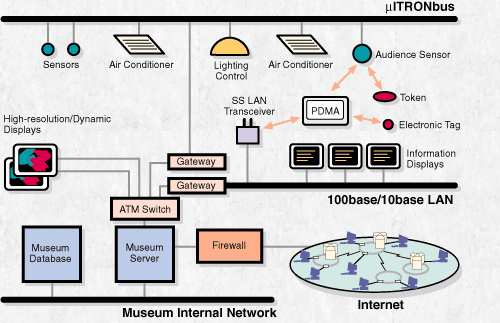
− Noboru Koshizuka −
Network system of Digital Museum connects all museum facilities including multimedia centers for digital data input of museum materials, database centers for storing digital archive data, virtual exhibition via the Internet, and exhibition rooms in museums for real exhibitions. Multimedia centers are facility for capturing several kinds of data for digital archiving such as photos, videos, and 3D-shape data. These data are sent to database centers, in which large multimedia databases stores these data. These stored data are used to build networked virtual exhibitions upon World Wide Web (WWW) or Multi User Dungeon (MUD). These data are also provided through the digital museum networks for information presentations in real museum exhibition spaces.
This intra-museum network is built in combination with several kinds of local area networks. Its backbone adopts high speed networks from a few hundred Mbps up to 1 Gbps such as ATM or Gigabit Ethernet. In their ends, middle speed networks about 100 Mbps such as FastEthernet are used. Moreover, in exhibition rooms, there are wireless communication systems for mobile computers or devices such as PDAs. Concretely, we adopt wireless LANs or in-house PHS systems.
The distributed museums connect these digital museum intra-networks with each other. Via this extra- inter-museum networks, multiple digital museums exchange their archives and form a large virtual "Inter-Museum" upon computer networks.
Fig.1 Distributed Museum Network
